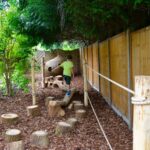Gardens can be a wonderful place for kids to explore, learn, and play. When designing a garden for children, it is important to consider their unique needs and interests. One key aspect of garden design for kids is creating spaces that are fun and engaging. This can be achieved by incorporating elements such as colorful flowers, interactive features like water features or stepping stones, and whimsical sculptures or decorations.
Another important consideration when designing a garden for kids is safety. It is essential to choose plants that are not toxic or harmful if ingested, and to avoid thorny or prickly plants that could cause injuries. Creating clear pathways and removing any tripping hazards will also help ensure a safe and enjoyable experience for children in the garden.
Incorporating sensory elements into the garden can also enhance the experience for kids. Plants with interesting textures, scents, and colors can engage children’s senses and stimulate their curiosity. Adding a variety of plants that appeal to different senses, such as lavender for its calming scent or lamb’s ear for its soft leaves, can create a diverse and stimulating sensory experience for children.
Another fun and educational aspect of garden design for kids is creating spaces for wildlife. Planting flowers that attract butterflies, bees, and birds can provide children with a unique opportunity to observe and learn about nature up close. Including bird feeders, insect hotels, or bat boxes can also encourage a diverse range of wildlife to visit the garden and create a thriving ecosystem.
Involving kids in the garden design process can be a great way to get them excited and invested in the space. Allowing them to help choose plants, design features, and decorations can foster a sense of ownership and pride in the garden. Giving children opportunities to plant, water, and care for the garden can also teach important lessons about responsibility and sustainability.
Ultimately, designing a garden for kids is all about creating a space that is fun, safe, and educational. By considering their unique needs and interests, incorporating engaging elements, promoting sensory experiences, attracting wildlife, and involving children in the design process, you can create a garden that will inspire young minds and provide hours of enjoyment for kids of all ages.












